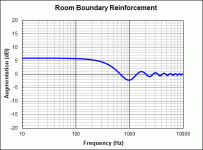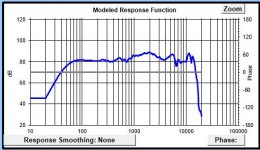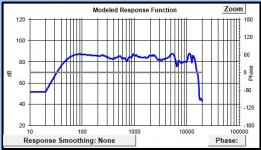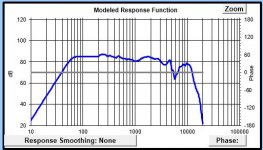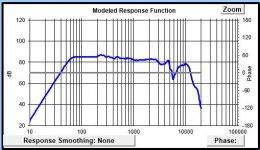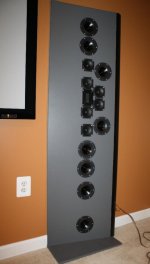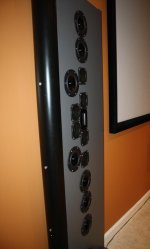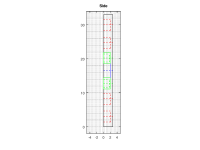I have my eyes on a pair Mark Audio CHR-70, and are browsing the application thread now. Leaning towards a golden ratio cabinet with port on the side. Interested in trying a onken-style cabinet, but I think I save that until a day with more tools and bigger space 🙂
I am interested in slim on-wall speakers as well. Maybe I missed the information in this thread, is this 2 way or 3-way speaker?
Hi! Thank you for all the answers! Interesting discussions 🙂
Like said in the beginning and also implied in the discussion, this is a difficult thing to simulate. I'm aware of that. My intention was not to simulate and try to get a "perfect" result. My intention was to simulate with a rather simple crossover, and try to check that with some simulations that include baffle step and room gain or acustic effect. After that maybe do some adjustments, but I realize that the simulations would have to much uncertainties in them to have as a base for complex crossover build, trying to compensate all the different effects.
Anyway. I have found myself in a state of over analyzing this project, in all aspects. And sometimes when you find yourself in that state, it stops being fun. So I have decided to let this idea rest. Instead I going to build something using a pair of full range drivers, which is something I also been thing about from time to time 🙂
Maybe it's too late for this or maybe you might reconsider.
If you are not looking for "perfect" results, I think the existing simulation tools can get you a perfectly "good enough" result.
Here are some pics below.
1 - wall gain using J Bagby's Diffraction and Boundary software. Distance from the wall = 5"
2- baffle diffraction sim with same program of 3" cone on a 5" x 16" front baffle. With 1/2" panels and 5" x 5" x 17" box, you'll have 3.9L to work with.
3 - TCP-4 in a 2L vented box
4 - TCP-4 combined with baffle diffraction and wall gain
You get a fairly large dip centered at around 1000Hz which is probably too hard to deal with for a simple xo design. What you need then is another driver that has more SPL in this frequency range. Below is the 1st one I tried but there are certainly more to choose from.
5 - Dayton ND105-4 in a 4L vented box
6 - ND105-4 with the same baffle diffraction and wall gain added
That now is a much more workable FR.
And that's about how easy it is.
If you can't get the software to work for you, just let me know and I'll post the files for you for whatever driver and with whatever baffle configuration you decide upon. Import those into XSim and you are good to go to work on the xo.
Or just ignore all of the above if you have truly let the idea go.
Attachments
My thin on-wall speakers ended up with this wedge shape. They are only 4.5 inches deep (on the outside, 1 inch deep on the inside), but about 20 inches wide (if you count the half-round PVC on the side). The wedge shape points them somewhat toward the listening position, and eliminates one edge diffraction.
One thing that helps is if you can overlap the reflections (positive mirror sources) and diffraction (negative edge sources) in time... that way they cancel each other to some degree. For that to work, you need some path lengths to the wall to be shorter than other path lengths to the baffle edge.
One thing that helps is if you can overlap the reflections (positive mirror sources) and diffraction (negative edge sources) in time... that way they cancel each other to some degree. For that to work, you need some path lengths to the wall to be shorter than other path lengths to the baffle edge.
Attachments
My thin on-wall speakers ended up with this wedge shape. They are only 4.5 inches deep (on the outside, 1 inch deep on the inside), but about 20 inches wide (if you count the half-round PVC on the side). The wedge shape points them somewhat toward the listening position, and eliminates one edge diffraction.
One thing that helps is if you can overlap the reflections (positive mirror sources) and diffraction (negative edge sources) in time... that way they cancel each other to some degree. For that to work, you need some path lengths to the wall to be shorter than other path lengths to the baffle edge.
Great stuff could you tell some more about your build drivers, dimensions etc.
Great stuff could you tell some more about your build drivers, dimensions etc.
It's hard to find drivers that work well in such a shallow speaker, and impossible to find ribbons that work, due to their transformers.
The incredibly shallow AST2560 was selected for the tweeter:
Aurum Cantus AST2560 Aero Striction Tweeter
Tymphany TC9FD18 full range drivers for the mids, due to bandwidth requirements:
Peerless by Tymphany TC9FD18-08 3-1/2" Full Range Paper Cone Woofer
The RS125 speakers are pretty shallow:
Dayton Audio RS125-4 5" Reference Woofer 4 Ohm
I am working on a simplified WWMTMWW version with the same drivers. Instead of using a wedge to create the diffraction-reflection cancellation I described above, I am using a large horizontal offset. The speakers will be placed very close to the inside edge, and far from the outside edge. With this configuration I can cut the depth down to less than 3 inches.
I have included a couple of design picks.
Attachments
- Home
- Loudspeakers
- Multi-Way
- First build: Slim wall speakers. Some startup questions
